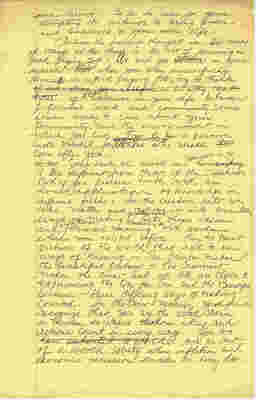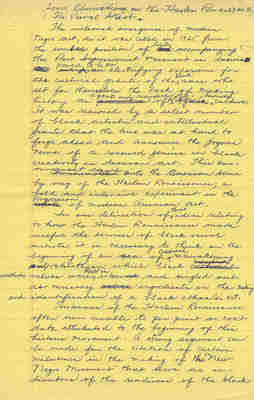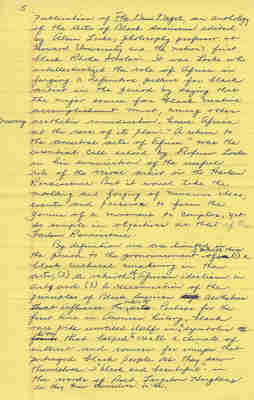Pages
MS01.01.03.B02.F05.005
[HANDWRITTEN]
own living. To do so calls for your attempting to continue to bring order and balance to your own life.
Perhaps the foremost though in the minds of many at this time is the act of securing a good paying job. We wish you [crossed out: success] well in your search -- [crossed out: but] and when you are successfully secure [crossed out: -d] in a good paying job, try to think [crossed out: of extending yourself in a way that will] of a healthy balance in your life between professional work and community service. Learn early to care about your community and the environment in which you live. Try to be a positive role model for [crossed out: your peers] and for those who shall [crossed out: be] come after you.
[crossed out: is no] Your task as artists and specialises in the humanity is no different from that of the scientist. Both of you pursue truth with an honest application of knowledge in different fields. In the creative arts we take matter and reshape it into our own ways of making. Producing writers and poets shape ideas and bring about formal meaning with words where none existed before. They too paint pictures of the world that add to our ways of knowing -- The painter makes the beautiful pictures -- The Scientist makes the cure -- And we all are closer to experiencing the One the True and the Beautiful because their differing ways of making counted. In the same manner, you [crossed out: -r] must recognize that you are the vital chain in human existence those ideas and actions count in every way. You too [crossed out: have inherited a world] are a part of a world society where inflation and economic recession knocks on every door.
MS01.01.03.B02.F05.006
[HANDWRITTEN]
To (Persons of administration present) -- dist Plt for guests, for the many graduates of the Dr Arts & Hum. I want to welcome you here, now join the graduates, [crossed out: and], their relations and friends in thanking you for your presence.
It is indeed an honor and a distinct pleasure to [crossed out: be called upon to we] share with you the crowning experience of your stay here at the University of Maryland. It is our sincere hope that your stay here [crossed out: it] has been rewarding [crossed out: for you] in your quest for knowledge in making new friends and opening up [crossed out: the] to you vistas of the world [crossed out: to you] that shall be important to [crossed out: you] in the years to come. Most importantly, we hope taht you have moved closer to fulfilling those goals and objectives in your lives taht shall enabled us to say the world has been made -- a more humane [crossed out: better] and safer place to live because you came this way and applied yourself to [crossed out: study] in the humanizing and creative fields [crossed out: disciplines] of learning.
It is our sincere hope that as you go on [crossed out: forth to the] with direction to professional careers in your field [crossed out: disciplines, fields] or to further study in your discipline that you will take the time to reflect on your life establishing for yourself goals and objectives that tie your life to a larger world than one which concerns itself with individual comfort and [crossed out: self] advancement of self. Remember that you are the vital link in the mighty chain of human existence which holds together, the philosophy of humanity, the history of human endeavors [crossed out: and the advancement of ideas relating to] in social, cultural religious and political arena [crossed out: affairs] and the world can [crossed out: only] be made a better place [crossed out: from wh] all humankind only [underscored] if you [crossed out: refrain from breaking or giving in to] continue to strive to improve upon the quality of life in every facet of your
MS01.01.03.B02.F05.027
Some Observations on the Harlem Renaissance: : The Visual Artist
The welcomed emergence of modern Negro art, as it was called in 1925, from the somber position of lazily [crossed out: and] accompanying the Post Impressionist Movement in America [crossed out: art] proved to be an [crossed out: was an] electrifying experience for the cultural giants of the black race who set for themselves the task of making history as agents and recorders [crossed out: promoters] of the new [crossed out: African] American culture. It was reasoned by a select number of black artistic and intellectual giants that the time was at hand to forge ahead and announce the joyous news of a renewed genius in black creativity in American art. This announcement came [crossed out: In our deliv...] onto the American scene by way of the Harlem Renaissance; a bold and intensive experiment in the [crossed out: whole] progression of modern American Art.
In our delineation of those ideas relating to how the Harlem Renaissance made useful the services of black visual artists, it is necessary to think on the beginning of an era of cultural reawakening and rebirth in which black [crossed out: creative cultural] aesthetic values were held in esteem [crossed out: -ed] and singled out as necessary [crossed out: values] ingredients in the making and identification of a black ethos in art.
Historians of the Harlem Renaissance oftem seem unable to pin-point an exact date attributed to the beginning of this historic movement. A strong argument can be made for the citation of certain milestones in the making of the "New Negro Movement" that serve as indicators of the readiness of the black
MS01.01.03.B02.F05.028
2 [HANDWRITTEN]
community in Harlem to forge ahead [crossed out: in] with a new cultural [crossed out: definition] direction which redefined black identity and the cultural role of its ethnic community. [crossed out: These] Some milestones are readily dated with time and place so as to make clear their association with the Harlem Renaissance.
As early as 1919, the date associated with the return of black soldiers from the Great War in Europe, signs of a changing cultural order appeared in the streets of Harlem manifesting themselves through literary clubs, art exhibitions and musical evenings that had as their [crossed out: goal] sole purpose the uplifting of the arts in the race. Those black soldiers who brought back from Europe the salient memories of the horrors of war they experienced in their service [crossed out: of the] New York's (Harlem's) 15th Infantry Regiment, returned to Harlem to the welcomed cheers of a new Negro mind -- one bent on [crossed out: feeling] changing its own way of living in American society. This 1919 date also pinpoints the unusual sagacity of a socially determined mind-set among black intellectuals who were beginning to congregate in Harlem, the cultural capitol of black America, many of whom [crossed out: of them] founded movements [crossed out: which] recked of black nationalism and an insightful recognition of Africa as the spiritual homeland of all black peoples of the diaspora.
Another date of equal significance in the year 1925, the time of the
MS01.01.03.B02.F05.029
3
Publication of "The New Negro, an anthology of the arts of Black Americans edited by Alain Locke, philosophy professor at Howard University and the nation's first black Rhode Scholar. It was Locke who intellectualized the role of Africa in forging a definitive posture for black artist in the period by saying that the major source for black creative accomplishment must, among other necessary aethetic consideration, have Africa at the core of its plan. "A return to the ancestral arts of Africa" was the essential call echoed by Professor Locke in his enunciation of the useful role of the visual artist in the Harlem Renaissance. But it would take the moulding and forging of numerous ideas, events and persons to form the genius of a movement so complex, yet so simple in objectives as that of the Harlem Renaissance.
By definition we are limited in the period to the pronouncement of 3 noticeable things!: (1) a black cultural awakening in the arts; (2) a rebirth of African idealism in art, and (3) a re-examination of the principles of Black American aesthetics that influence the making of art. Perhaps for the first time in American history, black race pride unveiled itself in a symbolic [crossed out: form] way that helped to create a climate of interest and concern for images that portrayed black people as they saw themselves: -- "black and beautiful"-- in the words of Poet Langston Hughes as they knew themselves to be.






